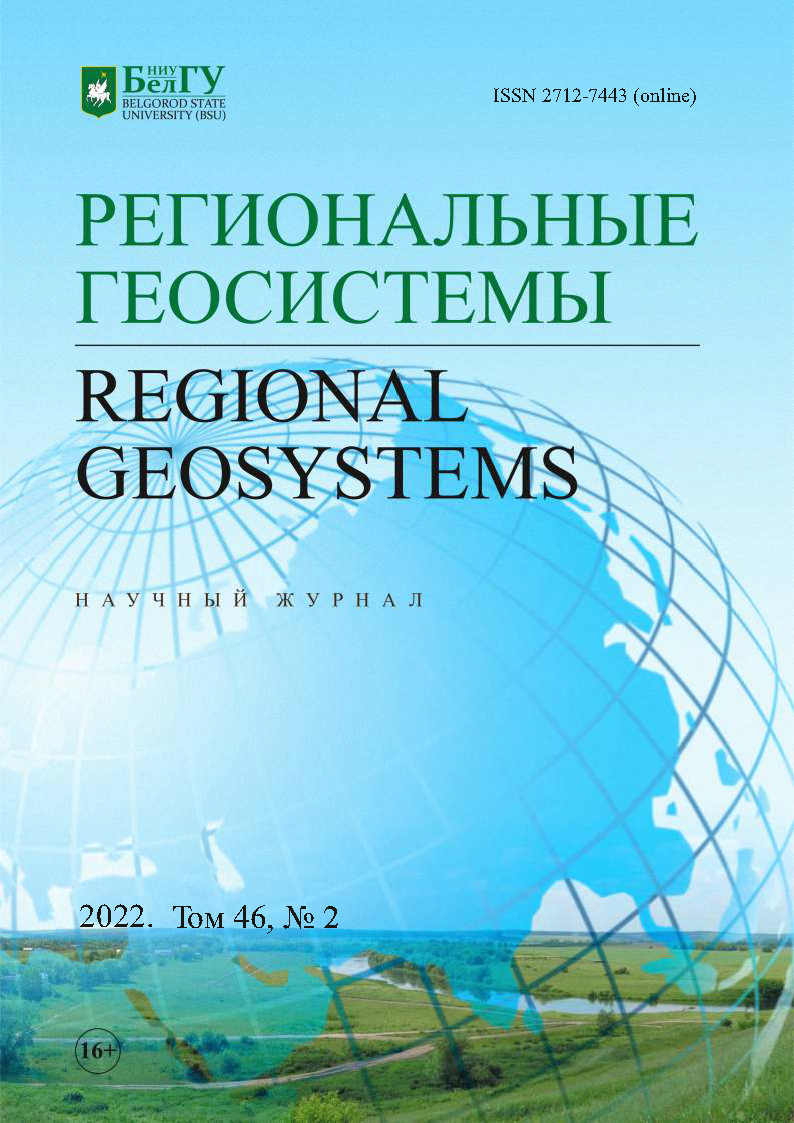Chemical Properties and Biological Activity of Soils on Akchagyl Clays in the Eastern Ciscaucasia under Conditions of Intensive Pasture Load
DOI:
https://doi.org/10.52575/2712-7443-2022-46-2-173-183Keywords:
Ciscaucasia, Solonetz, Light Kastanozem soils, winter pastures, active microbial biomass, mmicrobial respiration coefficient, urease activityAbstract
At present, there is an acute problem of disturbance of ecological balance in pasture ecosystems caused by natural and anthropogenic factors. Long-term and unsystematic use of pastures without taking into account ecological features has led to the deterioration of biological diversity, the development of degradation processes. Among pasture soils, the danger of overgrazing of winter pastures soils is especially susceptible, since grazing in winter occurs on moist soils, which leads to over consolidation, erosion and negative changes in a number of soil properties. In this regard, a study of soils developed on saline Pliocene deposits of the Akchagyl stage in the arid zone of the Eastern Ciscaucasia (Republic of Dagestan) was carried out. The purpose of the study was to analyze the effect of livestock grazing on the chemical properties and biological activity of soils on different relief elements. The basic chemical properties of chestnut soils and solonetzes in various geomorphological conditions and different intensity of pasture load have been studied. For the first time, data on the biological activity of winter pastures soils within the warm non-freezing soil-climatic facies were obtained. It is shown that in all cases very high values of the microbial respiration coefficient are observed, which indicates the stressful state of the microbial community. Taking into account the sensitivity and sensitivity of the microbial community to changes in external conditions, this approach can be effective in the ecological assessment of the state and forecasts of soil development.
Downloads
References
Агроклиматические ресурсы Дагестанской АССР. 1975. Л., Гидрометиздат, 112 с.
Александрова Э.А. 2019. Аналитическая химия. Книга 1. Химические методы анализа: учебник и практикум для СПО. М., Издательство Юрайт, 533 с.
Аринушкина Е.В. 1970. Руководство по химическому анализу почв. М., МГУ, 487 с.
Воробьева Л.А. 1998. Химический анализ почв. М., Изд-во МГУ, 272 с.
Государственный (национальный) доклад о состоянии и использовании земель в Российской Федерации. 2021. Москва, Росреестр, 197 с.
Стифатов Б.М., Рублинецкая Ю.В. 2017. Гравиметрический анализ: Методические указания к лабораторной работе. Самара, Самарский государственный технический университет, 35 с.
Асанов К.А., Алимаев И.И., Смоилов К.Ш. 1992. Выпас и его влияние на почвенный и растительный покров в Северной Казахстанской пустыне. Проблемы освоения пустынь,
: 7–13.
Благодатская Е.В., Ананьева Н.Д. 1996. Оценка устойчивости микробных сообществ в процессе разложения поллютантов в почве. Почвоведение, 11: 1341–1346.
Борисов А.В., Каширская Н.Н., Ельцов М.В., Пинской В.Н., Плеханова Л.Н., Идрисов И.А. 2021. Почвы древних земледельческих террас Восточного Кавказа. Почвоведение, 5: 542–557. DOI 10.31857/S0032180X2105004X.
Волож Ю.А., Быкадоров В.А., Царегородцева Т.К., Курина Е.Е. 2020. Акчагыльско-апшеронские отложения северной части Каспийского региона (Северный Каспий): особенности строения, эволюции и нефтегазоносности. Геология нефти и газа, 5: 39–53. DOI 10.31087/0016-7894-2020-5-39-53
Добровольский Г.В. 2000. Оценка экологического состояния почвенно-земельных ресурсов и окружающей природной среды Московской области. М., Издательство МГУ, 221 с.
Добровольский Г.В. 2002. Деградация и охрана почв. М., Изд-во МГУ, 654 с.
Идрисов И.А. 2010. Природные особенности Паласартской возвышенности (южный участок). Вестник Института истории, археологии и этнографии, 1 (21): 72–75.
Идрисов И.А. 2011. Формирование возвышенности Паласа-сырт. Вестник Института истории, археологии и этнографии, 1 (25): 121–124.
Котенко М.Е. 1993. Некоторые изменения светло-каштановых почв Терско-Сулакской низменности при различных пастбищных нагрузках. Почвоведение, 6: 108–111.
Мусейибов М.А. 1998. Физическая география Азербайджана. Баку, Мариф, 416 с.
Насиев Б.Н. 2015. Агрохимические параметры деградации почв кормовых угодий полупустынной зоны западно-Казахстанской области. Агрохимия, 9: 20–26.
Снакин В.В., Алябина И.О., Кречетов В.В. 1995. Экологическая оценка устойчивости почв к антропогенному воздействию. Известия Российской академии наук. Серия географическая, 5: 50–57.
Староверов В.Н., Савко А.Д. 2004. Фациальная модель формирования глинистых пород акчагыла Юго-Востока русской плиты. Вестник Воронежского государственного университета. Серия: геология, 1: 14–29.
Сушко К.С. 2015. Деградация каштановых почв сухих степей долины Маныча под влиянием хозяйственной деятельности. Автореф. дис. ... канд. геогр. наук. Ростов-на-Дону, 23 с.
Усманов Р.З., Баламирзоев М.А., Котенко М.Е., Бабаева М.А., Осипова С.В. 2010. Проблемы борьбы с деградацией и опустыниванием Кизлярских пастбищ в связи с аридизацией климата и антропогенных воздействий на природные экосистемы. Юг России: экология, развитие, 5 (3): 117–122.
Хохлова О.С., Хохлов А.А., Кузнецова А.М., Малашев В.Ю., Магомедов Р.Г. 2015. Изменение свойств почв при разнонаправленных климатических колебаниях позднего голоцена в полупустынной зоне (на примере курганного могильника Паласа-сырт, Дагестан). Почвоведение, 1: 31–48. DOI: 10.7868/S0032180X15010104.
Чернышева Е.В., Борисов А.В., Коробов Д.С. 2016. Биологическая память почв и культурных слоев археологических памятников. М., ГЕОС, 240 с.
Шеин Е.В., Карпачевский Л.О. 2007. Теории и методы физики почв. Москва, Гриф и К, 616 с.
Экологическое нормирование и управление качеством почв и земель. 2013. Под ред. С.А. Шобы, А.С. Яковлева, Н.Г. Рыбальского. М., НИА-Природа, 310 с.
Anderson J.P.E., Domsch K.H.A. 1978. A Physiological Method for the Quantitative Measurement of Microbial Biomass in Soils. Soil Biology and Biochemistry, 10 (3): 215–221. DOI: 10.1016/0038-0717(78)90099-8.
Kandeler E., Gerber H. 1988. Short-Term Assay of Urease Activity Using Colorimetric Determination of Ammonium. Biology and fertility of soils, 6: 68–72. DOI: 10.1007/BF00257924.
Abstract views: 213
Share
Published
How to Cite
Issue
Section
Copyright (c) 2022 REGIONAL GEOSYSTEMS

This work is licensed under a Creative Commons Attribution 4.0 International License.


